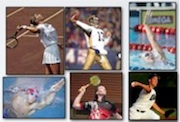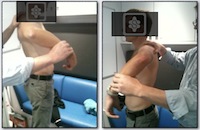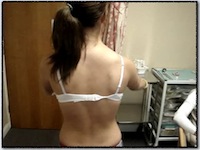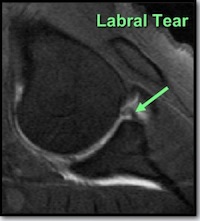The Athletes Shoulder - When to Operate
A FUNCTIONAL & STRUCTURAL APPROACH
Lennard Funk, 2011
Introduction:
 Athletes are unique in that their demands are specialised to their specific sport and activity with extreme demands on their shoulder unique to their particular position and sport. They are unique in that their job is seasonal and injuries and treatment thus so as well. The mechanisms of injury are very specific to their particular sport with unique injury patterns in certain sports such as the swimmer’s shoulder, volleyball shoulder, rugby shoulder etc. There is also a lot of anxiety around a professional athletes injury, not only from the athlete themselves but from their coaches, dependents and their sports agent. The decision to operate on an athlete should never be taken lightly and generally always involves a multi-disciplinary approach including the surgeon, team therapist and team doctor.
Athletes are unique in that their demands are specialised to their specific sport and activity with extreme demands on their shoulder unique to their particular position and sport. They are unique in that their job is seasonal and injuries and treatment thus so as well. The mechanisms of injury are very specific to their particular sport with unique injury patterns in certain sports such as the swimmer’s shoulder, volleyball shoulder, rugby shoulder etc. There is also a lot of anxiety around a professional athletes injury, not only from the athlete themselves but from their coaches, dependents and their sports agent. The decision to operate on an athlete should never be taken lightly and generally always involves a multi-disciplinary approach including the surgeon, team therapist and team doctor.
Making the diagnosis:
I like to think of athletes injuries in ‘functional’ and ‘structural’ component, basing the clinical assessment and treatment decision-making on both these elements. Athletes injuries are generally predominantly a functional injury or structural problem. Structural lesions are those pertaining to a structure. These are injuries to the passive structures of the shoulder such as the labrum, tendons, ligaments and bones.Functional injuries are those involving or affecting function rather than physiology and this involves the dynamic structures such as the muscles and nerves.
To assess these the clinical examination can be broken down into the structural examination and the functional examination.
1. Structural examination includes:
i. Labral load test.ii. Rotator cuff weakness.
iii. Passive impingement tests.
iv. AC joint load tests.
v. Proximal biceps tests.
2. Functional examination includes:
i. Capsular tightness.ii. Scapular dyskinesia.
iii. Core stability.
iv. Thoracic spine.
v. Proprioception.
This assessment is useful to guide the treatment with regards to the roles of rehabilitation and surgical intervention as structural lesions will almost certainly require surgical intervention whereas functional problems found at examination are managed non-operatively with physiotherapy interventions.
Posterior capsular laxity on the leading shoulder of a professional golfer:

Scapula dyskinesia in a professional tennis player with atraumatic instability:

The role of imaging:
The role of imaging is to assist with diagnosis of static structural lesions. The preferred imaging modality for athletes and that most commonly used is MR arthrogram. This will give good definition of the soft tissue structures as well as the bony structures and cartilage. The inclusion of an ABER view (abduction/external rotation) is helpful for overhead athletes and for assessing partial cuff tears and labral tears. CT arthrogram is particularly useful for showing the bony anatomy as well as indicated in patients who have had previous surgery with implants that may interfere with the MR scans.SLAP Tear on MR arthrogram ABER view:

Indications for surgery after injury:
Those patients which will almost certainly require surgical intervention are those athletes with a confirmed structural injury on imaging after a traumatic injury and those particular patients are athletes which do not respond to rehabilitation in a very short time after the injury (a few weeks).Indications for surgery in the athlete’s chronic shoulder are:
1. Those athletes not responding to rehabilitation within months rather than weeks.
2. A negative functional examination.
3. A positive structural examination.
4. (A confirmed structural injury on imaging).
An example is a javelin thrower that has developed shoulder pain with repeated throwing that initially responds well to rehabilitation but develops increased clicking and pain from their shoulder and MR arthrogram suggests a possible superior labral pathology and some oedema in the greater tuberosity. This is suggestive of a possible small-acquired SLAP tear particularly once functional aspects have been dealt with, treated and eliminated. This would be the stage and indication for surgical intervention.


